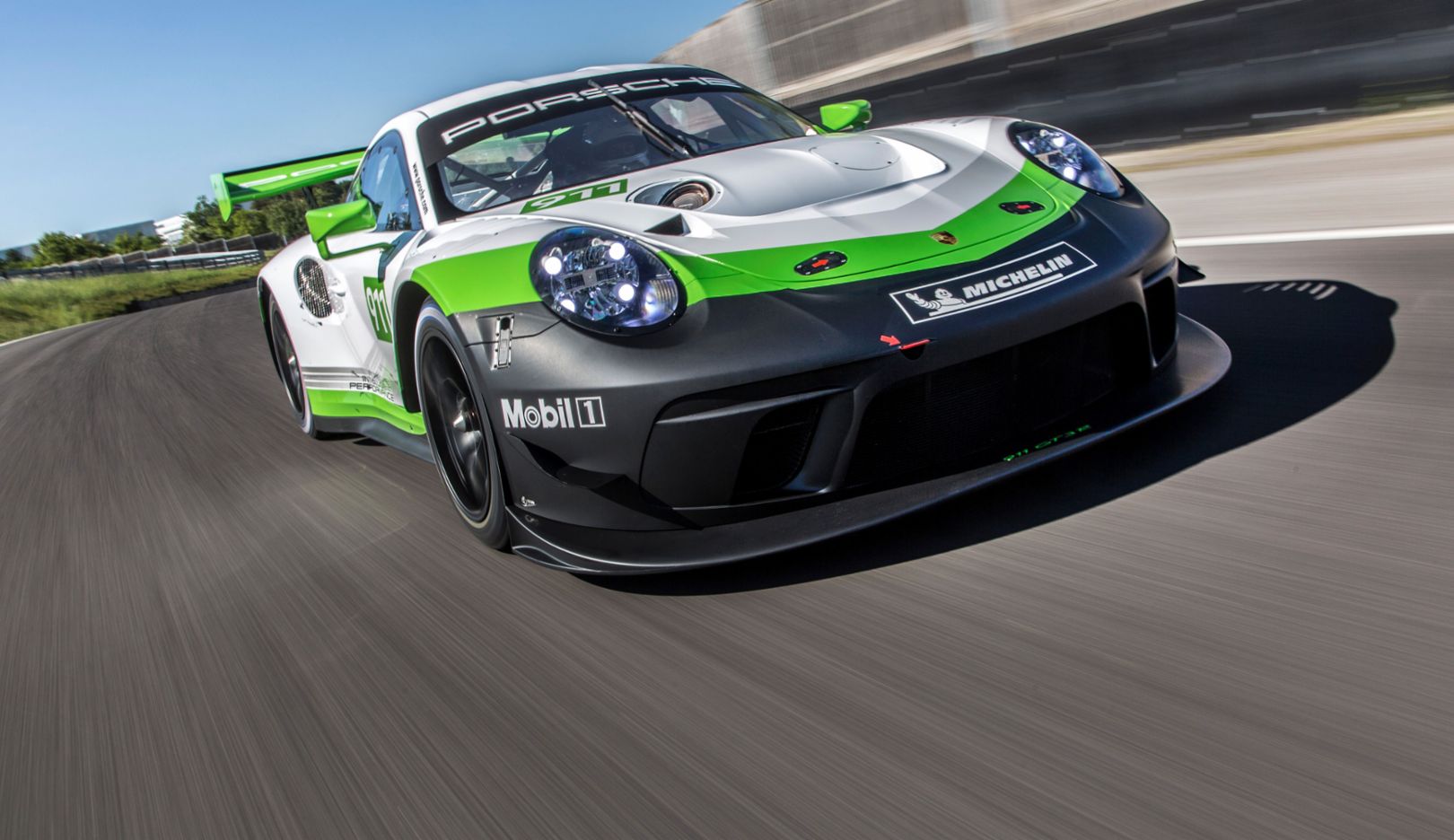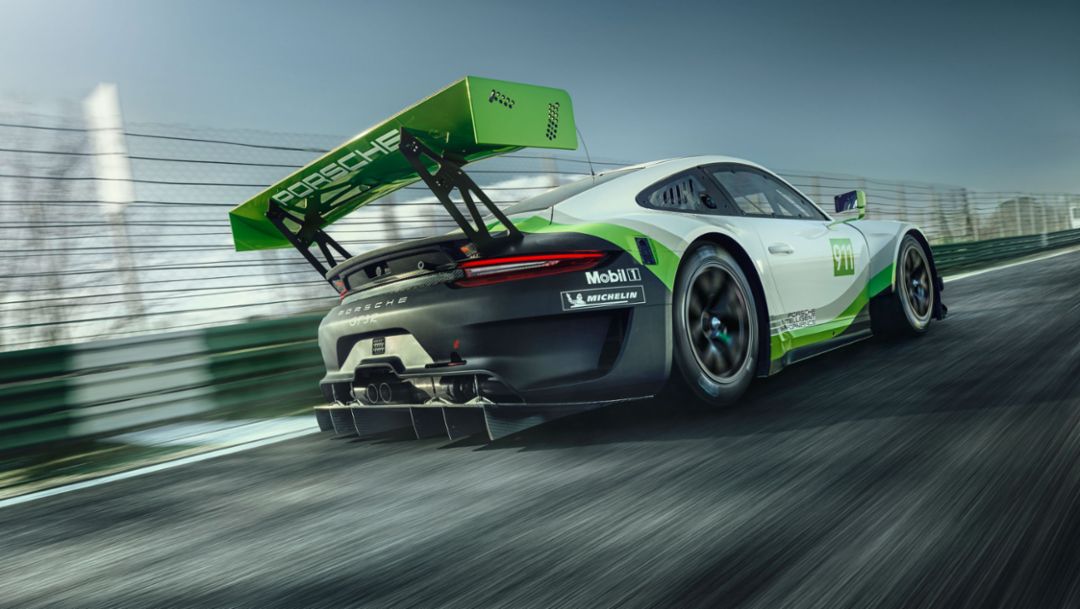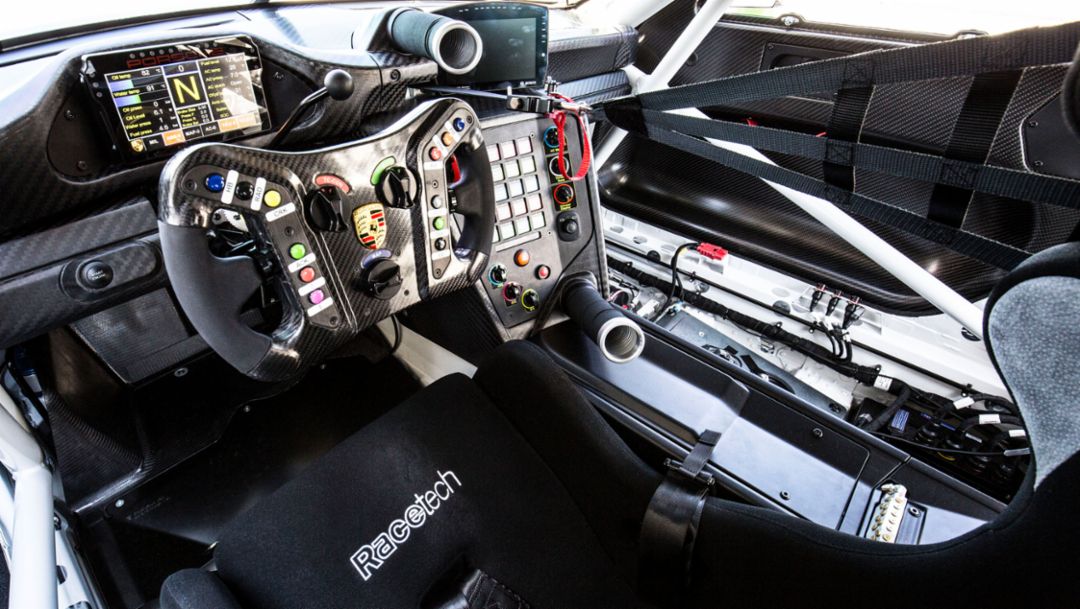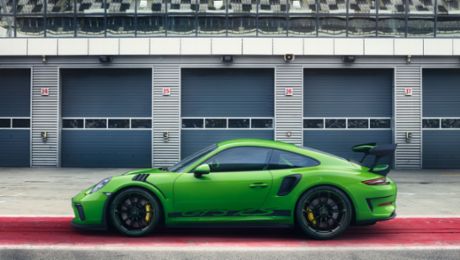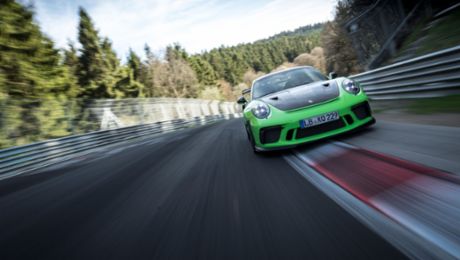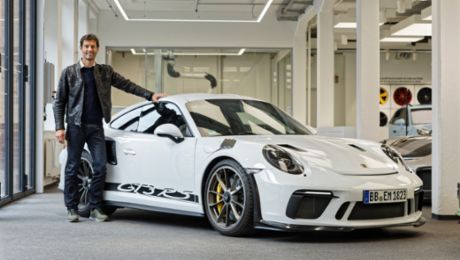During the development of the up to 404 kW (550 hp)* racing nine-eleven, special attention was paid to particularly efficient aerodynamics, further optimised safety as well as lowering the cost of servicing and spare parts.
The lightweight body design of the 911 GT3 RS production sports car featuring intelligent aluminium-steel composite construction has proven to be the ideal basis for the near-production race car. The roof, front hood and fairing, wheel arches, doors, side and tail sections as well as the rear lid and interior trim are made of particularly light carbon-fibre composite material (CFRP). All windows consist of polycarbonate.
The normally-aspirated engine offers significantly better driveability
Powering the new 911 GT3 R is a cutting-edge four-litre flat-six unit which is largely identical to the high-performance production engine of the road-legal 911 GT3 RS (911 GT3 RS: Fuel consumption combined 12.8 l/100 km; CO2 emissions 291 g/km). Direct fuel injection, which operates at pressures up to 200 bar, as well as variable valve timing adjustments of the intake and exhaust camshafts ensure a particularly efficient use of fuel. Moreover, compared to its predecessor, the normally-aspirated engine offers significantly better driveability and a broader usable rev range. The engine response is more precise due to six throttle butterflies. Power from the rear engine is transferred to the 310-mm-wide rear wheels via a Porsche sequential six-speed constant-mesh gearbox with an electronic shift actuator for particularly fast and precise gear changes. As in the GT road-going models, the driver changes gears via shift paddles conveniently positioned on the steering wheel. The clutch is electro-hydraulically controlled, which eliminates the need for the clutch pedal and assists quick race starts. Typical of the 911, the weight distribution ensures excellent traction and braking performances.
The spectacular aerodynamics of the 911 GT3 R also follows the example of the road car. The distinctive wheel arch air vents on the front fairings increase downforce at the front axle. Measuring 1,900 millimetres in width by 400 millimetres in depth, the rear wing lends aerodynamic balance. The tyre circumference at the front axle has grown from 650 to 680 millimetres. In tandem with the new Porsche double wishbone suspension, this ensures superior braking performances and consistency over the duration of the race.
The brake system of the 911 GT3 R also underwent further modifications and now offers increased stiffness and more precise control of the ABS. At the front axle, six-piston aluminium monobloc racing brake callipers combined with ventilated and grooved steel brake discs with a diameter of 390 millimetres ensure outstanding braking performances. Fitted at the rear axle are four-piston callipers and discs measuring 370 millimetres.
All controls have been perfectly aligned to suit the needs of the driver
Another development focus was on the safety features of the 911 GT3 R. In order to improve pit stop performance, the 120-litre FT3 safety fuel cell can now be refilled from the left or the right depending on the circuit layout. The doors and the side windows can be removed. The new racing bucket seat affords pilots even better protection in the event of a collision. The seats are now bolted at six points. In combination with the adjustable pedal box, the driver’s centre of gravity is optimised and offers increased safety in the event of an impact. In addition, the driver is protected thanks to a side impact element positioned in the driver’s door, which consists of a carbon-fibre Kevlar aluminium construction with energy-absorbing plastic foam.
The cockpit has been redesigned. All controls have been perfectly aligned to suit the needs of the driver. For the first time the 911 GT3 R features air-conditioning. This ensures ideal interior cooling and, thanks to the direct connection to the seat and driver’s helmet, enables particularly efficient cooling of the driver, which in turn helps them maintain concentration and a constant performance over the race.
#911GT3R - Unveiled: The new #Porsche #911GT3R #MomentsofRacing @PorscheNewsroom pic.twitter.com/HgpjzRn5ya
— Porsche Motorsport (@PorscheRaces) 11. Mai 2018
(991, Gen. 2)
All technical details and data are provisional until the final approval is received through FIA.
Concept
Single-seater customer race car based on the Porsche 911 GT3 RS
Engine
- Water-cooled six-cylinder boxer engine (rear mounted)
- 4,000 cm3; stroke 81.5 mm; bore 102 mm
- Output: over 404 kW (550 hp) without restrictors, actual output dependent on FIA BoP (restrictor)
- Single mass flywheel
- Four-valve technology
- Direct fuel injection
- Fuel supply: Super Plus lead free, to E20 (min. 98 Octane)
- Dry sump lubrication
- Electronic engine management BOSCH MS 6.4 with integrated data acquisition (basic memory 1 GB, max. 100 freely selectable channels)
- Race exhaust system (motorsport catalyst and country-specific pre-silencer available)
- Six electronically operated throttle valves
Transmission
- Porsche sequential six-speed constant-mesh gearbox
- Mechanical slip differential with external pre-load adjustment
- Racing clutch
- Paddle-shift with electronic shift drum actuator
Bodyshell
- Lightweight body featuring intelligent aluminium-steel composite design
- Welded-in roll cage according to FIA regulations
- Removable escape hatch in roof in accordance with the latest FIA regulations
- Vehicle recovery system tow points
- Lightweight exterior: CFRP doors with racing mirrors, CFRP rear lid with quick release fasteners, CFRP rear wing, adjustable, CFRP extended front fenders and wheel arch louvers, CFRP front fairing and cooling air ducting, CFRP rear fairing, Polycarbonate glazing, Removable polycarbonate door windows
- Modified 911 cockpit: CFRP interior trim, Ergonomic centre console aligned to driver with digital multi-touch panel, Multi-function racing steering wheel with quick release coupling and shift paddles
- Racing bucket seat in accordance with FIA standard 8862/2009: Six-point fixed bolting, Integrated air conditioning
- Six-point safety harness
- Ca. 120-litre FT3 safety fuel cell with fuel cut off safety valve in accordance with FIA regulations and changeable left and right refuelling
- Air jack system (four jacks)
Suspension
Front axle
- Double wishbone front axle
- Forged aluminium control arms: Stiffness-optimised, High performance spherical bearings
- Wheel hubs with centre-lock wheel nuts
- Motorsport vibration damper, 4-way adjustable
- Anti-roll bar, adjustable by blade position
- Power-assisted steering with electro-hydraulic pressure feed
- Setup changes without new alignment via shim system
Rear axle
- Multi-link rear axle
- Machined aluminium control arms, stiffness optimised with high performance spherical bearings
- Wheel hubs with centre-lock wheel nuts
- Motorsport vibration damper, 4-way adjustable
- Machined aluminium mounts
- Anti-roll bar, adjustable by blade position
- Setup changes without new alignment via shim system
Brake system
Two separate brake circuits for front and rear axles, adjustable by driver via balance bar system
Front axle
- Six-piston aluminium monobloc racing brake calliper
- Steel brake discs, multi-piece, ventilated, D = 390 mm
- Racing brake pads
- Twin-flow brake cooling ducts
Rear axle
- Four-piston aluminium monobloc racing brake calliper
- Steel brake discs, multi-piece, ventilated, D = 370 mm
- Racing brake pads
- Twin-flow brake cooling ducts
Rims/Tyres
Front axle
- One-piece BBS alloy wheels according to Porsche specification, 12.5 J x 18
- Michelin transport tyres; tyre dimension: 300/680-18
Rear axle
- One-piece BBS alloy wheels according to Porsche specification, 13J x 18
- Michelin transport tyres; tyre dimension: 310/710-18
Electrics
- COSWORTH colour display CDU
- COSWORTH Logger CLU (6 GB memory)
- COSWORTH power management system IPS48 MK2
- Porsche Motorsport traction control PMTC
- Fire extinguisher system (agent: gas)
- Battery 12 V, 60 Ah (LiFePo lithium ion), leak-proof, mounted in passenger footwell
- Multifunctional CFRP motorsport steering wheel with quick release coupling
- Digital multi-touch panel
- BOSCH LIN 175A alternator regulator
- BOSCH racing-ABS, generation 5
- Single-blade wiper with direct drive
- Optional BOSCH CAS Integration (race ready)
- LED main headlights
- Rear and rain lights with LED technology
Optional (factory installation)
- IMSA kit: Windshield braces, Rear window braces
- Sensor package
- FIA endurance kit: 2 LED extra lights in front fairing, Clutch fan, Telemetry GSM Low-Band (R+)
- Motorsport catalyst (depending on regulations)
- Heated windshield
After-sales options
- Option 1: Channel extension for detailed engine data recording, fastest recording rate 1,000 Hz
- Option 2: Data copy from internal memory of the engine data recording to an external USB stick
- More options: Front silencer, Tyre pressure monitoring system (TPMS), Cockpit lighting, Start number illumination, 2 LED auxiliary headlights
Weight/dimensions
- Total weight: tbd (BoP dependent)
- Overall length: 4,629 mm
- Overall width front axle: 1,975 mm
- Overall width rear axle: 2,002 mm
- Wheelbase: 2,459 mm
Colour
- Body painted with water-soluble paint: white C9A
- Interior: white primer with clear-coat finish
- Body parts in plain carbon (front and rear fairings, front lid, rear lid, doors, wheel arches, rear wing)
Consumption data
911 GT3 RS: Fuel consumption combined 12.8 l/100 km; CO2 emissions 291 g/km
911 GT3: Fuel consumption combined 12.9 – 12.7 l/100 km; CO2 emissions 290 – 288 g/km
